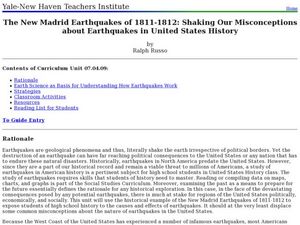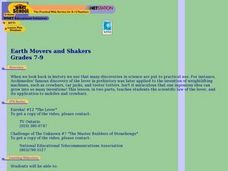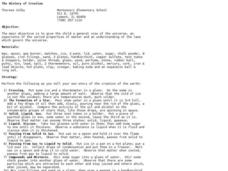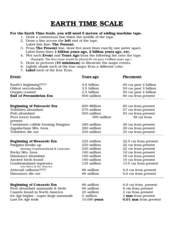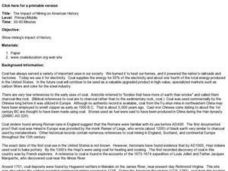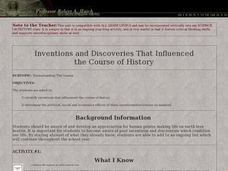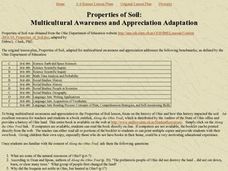Curated OER
Earth: The Food We Eat, The Seeds We Sow
Students explore the importance of seed diversity for cultural and ecological stability/health. They discover what an heirloom seed is and why they are important to conserve.
Curated OER
The New Madrid Earthquakes of 1811-1812: Shaking Our Misconceptions about Earthquakes in United States History
Young scholars Examine how earthquakes work and what plate tectonics and fault lines are. In this earthquake lesson students complete an earthquake scavenger hunt.
Curated OER
Dino History
Students create a timeline of the times dinosaurs lived. In this dinosaur timeline lesson, students research the various periods when dinosaurs lived. Students work in groups to research the dinosaurs of a specific time...
Curated OER
Earth Movers and Shakers
Students explore how the centuries-old invention of the lever led to today's applications in mobiles and crowbars. They watch a video on the lever, then utilize worksheets imbedded in this plan to guide their experiments.
Curated OER
Elephant Earth Adventures . . .
In this reading comprehension about African elephants worksheet, students read factual passages about their physical characteristics, amazing facts, tusk uses, ears, trunk, skin, movement, food needs, extended families, and the active...
Curated OER
Linking Kwanzaa to Technology and History
Seventh graders use the Internet to research the holiday of Kwanzaa. Using the information, they create a brochure to promote the holiday to others. They email the information to a friend to end the lesson.
Curated OER
The History of Creation
Learners explore the properties of matter. In this lesson about matter, students will do a series of experiments to enable them to understand about creation of the universe. In these some of the experiments learners will makes stars,...
Curated OER
the biggest Plates on Earth
Students understand the movement of tectonic plates. In this tectonic plates lesson plan, students access prior knowledge of convergent, divergent, and transform boundaries. Students discuss energy transfer involved in plate...
Curated OER
Fantastic Fossils
Young scholars learn about the kinds of fossils and what scientists can learn from them. In this earth science lesson, students are told how engineers and paleontologists work together. Then young scholars create a "fossil...
Curated OER
Bacteria Change Earth's Atmosphere
Tenth graders organize information to explain how photosynthetic bacteria contributed to climatic changes that happened on Earth. Students create a timeline by using a storyboard to tell the story of the change.
Curated OER
History of Astronomy
Students participate in assessments regarding the history of astronomy. They listen and take notes, draw a time line, draw a solar sytem designed by Ptolemy and create flashcards. They write an essay on Galileo, watch a video, take a...
Curated OER
Earth Time Scale
Students research the past eras in history including the Precambrian, Paleozoic, Mesozoic and the Cenozoic. For this time scale lesson students take part in a lab that allows the students a better understanding of the timeline of...
Curated OER
Breaking News English: Live Earth Rocks 2 Billion Worldwide
In this English worksheet, students read "Live Earth Rocks 2 Billion Worldwide," and then respond to 1 essay, 47 fill in the blank, 7 short answer, 20 matching, and 8 true or false questions about the selection.
Curated OER
The Impact of Mining on American History
Students listen to background information about coal and its mining in the United States history. They then construct a timeline using the above article. Illustrate with pictures from the www.coaleducation.org web site.
Curated OER
Dinosaur History (Part 5)
Eighth graders read the scripture that cooresponds with this lesson on dinosaurs. As a class, they review the great flood and discuss how the animals on the ark repopulated the Earth. They read more verses and answer questions to be...
Curated OER
History of Congress and Government
Seventh graders will perform research that helps them to learn about government and the democratic way of life. This form of life serves as a basis of reflection for the basic forms of life on earth.
Curated OER
Inventions and Discoveries That Influenced the Course of History
Students identify inventions that influenced the course of history and determine the political, social and economics effects of these inventions/discoveries on mankind. They conduct individual research and participate in class discussion.
Curated OER
National expansion of the United States (1815 to 1850), and its connection to local Illinois history.
Students discuss the importance of establishing the I & M Canal water route. They watch a video about the canal's history. They collect and write a personal migration story by interviewing a family member. They analyze trends and...
Curated OER
The Rifting of Pangaea and the Gettysburg Battlefield
Eleventh graders analyze and interpret an animated model of Earth’s rifting processes. In this Earth Science lesson, 11th graders connect Earth’s rifting processes with the Earth’s surface in the Gettysburg battlefield. ...
Curated OER
History Trifold in Publisher
Young scholars create a timeline of events happening around the world. For this timeline lesson plan, students use Microsoft Publisher to create a timeline of events happening around the world as they live their lives presently.
Curated OER
Properties of Soil
Students use history to create knowledge of how soil has changed in the state of Ohio. The lesson is cross curricular in nature and uses Along the Ohio Trail as a source of literature for reflection.
Curated OER
Revolutions Around the World
Revolutions are an interesting and informative way to study world history.
American Museum of Natural History
Fossils
Sixteen slides showcase an average day on the job for a paleontologist, Ross MacPhee. Engaging images include world maps and real-world photographs from an archeological dig in Antarctica. A brief description accompanies each slide.
American Museum of Natural History
Create a Compass
Historically, humans have used many methods of finding due north. Using a hands-on activity, learners create their own compasses. They then test their compasses in their neighborhood or to assist with stargazing.
Other popular searches
- Earth's History Time Line
- Soil and Earth's History
- Powerpoint Earth's History
- Earth's History Timeline

